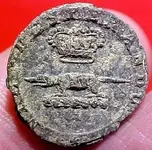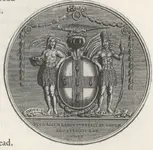Great find. For sure that's going to be a rare button. I have some random comments and observations.
Jamaica has no alligators… only crocodiles (one species), so that’s what the emblem is. It has a long history of association with Jamaica, having been jncluded as the crest for the colony’s armorial granted by Royal Warrant on 3rd February 1661. The original design had the crocodile on a log “fesse” (laying horizontally) but the log has not always been included on later representations. It's not seen on this one from 1687 for example:
View attachment 1996795
Jamaica was the first British colony to receive its own arms under Royal Warrant and the armorial was given the distinction of being crowned with a Royal Helmet and the Mantlings of the British Monarchy.
The original motto on the arms was INDUS UTERQUE SERVIET UNI (literally "The two Indians will serve as one", or "Both Indies will serve Together") in reference to the collective servitude of the Taino and Arawak Indians to the colonisers. The Latin version was replaced in 1962 by what was deemed to be a more politically acceptable English equivalent as "Out of Many, One People".
The crown on the button is of a style not used for official purposes beyond 1901. Were crowns of this type used on livery buttons? Yes, but not on family buttons, although quite possibly on livery crests granted to companies/services at civic level (livery is not confined to family heritage), or for government organisations and services, both military and uniformed non-military.
The “rope border thing” referred to by Crusader in post #16 is a “torse”… a twisted wreath of silver (or white) and red silk depicted edgewise, either straight, or more usually with slight curvature, like this:
View attachment 1996796
In heraldry, it separates the top of the helmet on an armorial from the base of the crest, masking the join between them and holding the mantling in place. When seen only with the crest (as for the crocodile on the button) it usually means the depicted crest is not a standalone emblem, but part of a full armorial for which the other elements have been intentionally omitted (eg because of space limitations or for other reasons).
The button motto does seem to be “NIL DESPERANDUM” (Never Despair). That has never been an official Jamaican motto, but was the motto accompanying the armorial of at least two prominent families in Jamaica… the Sampson family and the Knill family, although neither used the crocodile as an emblem for their personal crests. The army regulars and local recruits (such as the “Accompong Maroons”) on the island were supported by militia groups under the control of plantation owners (eg by Colonel William Grignon, who ran several estates), so that creates a possibility for either the Sampsons or the Knills to have had such a group under their control. There was a general mobilisation of militia groups to help put down the armed rebellion of some 60,000 slaves in 1831/2.
One other possibility sprang to mind. On 11th December 1882 the Jamaican capital, Kingston, suffered a great disaster. A disgruntled employee of the Alexander Feurtado Lumber Company, Edward Foster, set fire to his employer’s premises and the out-of-control blaze pretty much destroyed half the city, including a large portion of its business district. Some 6,000 people were left homeless, official premises/city services destroyed and many businessmen ruined. In the aftermath of the fire, the phrase “Nil Desperandum” was seemingly adopted as a motto by many of those determined to rebuild what they or the city had lost.
For example, the “Jamaica Gleaner” newspaper of 10th March 1883 reported (in relation to a grocer and druggist advertising with them): “
We are pleased to see that Mr. Samuel R. Da Costa of 119 Harbour Street, has adopted the principle expressed in the heading of his advertisement, Nil Desperandum, and has determined not to sit down and weep over spilt milk. He has re-opened with a large supply of articles of household necessity, and will endeavour by perseverance and pluck to regain at least a portion of the loss which has overtaken him, as well as numerous other of his fellow citizens. We wish Mr. Da Costa every success in his renewed undertaking."
There’s also an advert in the 1891 Business Directory for “A. Brandon Son: Marble Workers, Painters” of 87 Harbour Street, Kingston headed with the same “
Nil Desperandum” phrase, so the spirit of the message seems to have lasted for some years.










